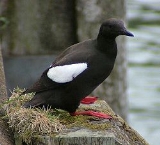
Cepphus
Encyclopedia
Cepphus is a genus of seabird
s in the auk
family also referred to as true guillemot
s or, in North America, simply as guillemots. These are medium-sized birds with mainly black plumage in the breeding season, thin dark bills and red legs and feet. Two species have white wing patches, the third has white facial “spectacles”. They are much paler in winter plumage, mottled above and white below.
The breeding habitat is rocky shores and islands on the coasts of the northern Atlantic
and Pacific Ocean
s. They usually lay their eggs in rocky sites near water.
These birds may overwinter in their breeding areas, moving to open waters if necessary, but usually not migrating
very far south.
They dive for food from the surface, swimming underwater. They mainly eat fish
and crustaceans, also some molluscs, insect
s and plant material.
The species are:
There are also fossil forms
The latter two resemble the extant species, but because of the considerable distance in time or space from their current occurrence may represent distinct species.
Seabird
Seabirds are birds that have adapted to life within the marine environment. While seabirds vary greatly in lifestyle, behaviour and physiology, they often exhibit striking convergent evolution, as the same environmental problems and feeding niches have resulted in similar adaptations...
s in the auk
Auk
An auk is a bird of the family Alcidae in the order Charadriiformes. Auks are superficially similar to penguins due to their black-and-white colours, their upright posture and some of their habits...
family also referred to as true guillemot
Guillemot
Guillemots is the common name for several species of seabird in the auk family . In British use, the term comprises two genera: Uria and Cepphus. In North America the Uria species are called "murres" and only the Cepphus species are called "guillemots"...
s or, in North America, simply as guillemots. These are medium-sized birds with mainly black plumage in the breeding season, thin dark bills and red legs and feet. Two species have white wing patches, the third has white facial “spectacles”. They are much paler in winter plumage, mottled above and white below.
The breeding habitat is rocky shores and islands on the coasts of the northern Atlantic
Atlantic Ocean
The Atlantic Ocean is the second-largest of the world's oceanic divisions. With a total area of about , it covers approximately 20% of the Earth's surface and about 26% of its water surface area...
and Pacific Ocean
Pacific Ocean
The Pacific Ocean is the largest of the Earth's oceanic divisions. It extends from the Arctic in the north to the Southern Ocean in the south, bounded by Asia and Australia in the west, and the Americas in the east.At 165.2 million square kilometres in area, this largest division of the World...
s. They usually lay their eggs in rocky sites near water.
These birds may overwinter in their breeding areas, moving to open waters if necessary, but usually not migrating
Bird migration
Bird migration is the regular seasonal journey undertaken by many species of birds. Bird movements include those made in response to changes in food availability, habitat or weather. Sometimes, journeys are not termed "true migration" because they are irregular or in only one direction...
very far south.
They dive for food from the surface, swimming underwater. They mainly eat fish
Fish
Fish are a paraphyletic group of organisms that consist of all gill-bearing aquatic vertebrate animals that lack limbs with digits. Included in this definition are the living hagfish, lampreys, and cartilaginous and bony fish, as well as various extinct related groups...
and crustaceans, also some molluscs, insect
Insect
Insects are a class of living creatures within the arthropods that have a chitinous exoskeleton, a three-part body , three pairs of jointed legs, compound eyes, and two antennae...
s and plant material.
The species are:
- Black GuillemotBlack GuillemotThe Black Guillemot or Tystie is a medium-sized alcid.Adult birds have black bodies with a white wing patch, a thin dark bill, and red legs and feet. They show white wing linings in flight. In winter, the upperparts are pale grey and the underparts are white. The wings remain black with the large...
or Tystie, Cepphus grylle - Pigeon GuillemotPigeon GuillemotThe Pigeon Guillemot is a medium-sized alcid endemic to the Pacific. They closely resemble the other members of the genus Cepphus, particularly the Black Guillemot, which is slightly smaller....
, Cepphus columba - Spectacled GuillemotSpectacled GuillemotThe Spectacled, or Sooty Guillemot, Cepphus carbo, is a seabird in the auk family.-Description:This species is about 38 cm long, with red legs, black bill and a blackish iris....
, Cepphus carbo
There are also fossil forms
- Cepphus olsoni (San Luis Rey River Late Miocene - Early Pliocene of W USA)
- Cepphus cf. columba (Lawrence Canyon Early Pliocene of W USA)
- Cepphus cf. grylle (San Diego Late Pliocene, W USA)
The latter two resemble the extant species, but because of the considerable distance in time or space from their current occurrence may represent distinct species.

